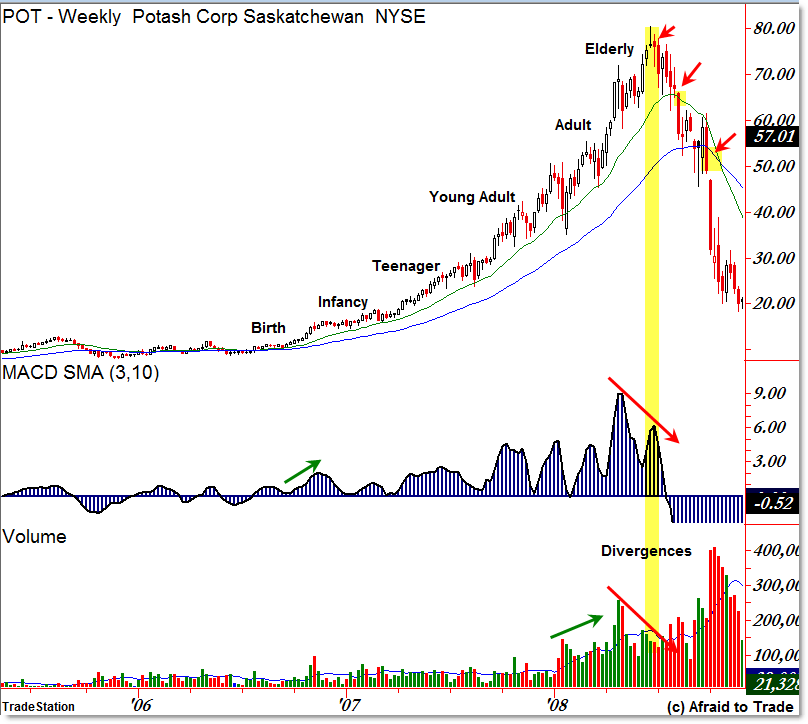Wednesdays with Wyckoff: Life Cycle Stages of a Stock
It’s time for another “Wednesdays with Wyckoff” Lesson!
If you’ve been following along, you know that Richard Wyckoff – an early technical analysis thinker – often mixes entertaining if not colorful imagery into his practical lessons about supply/demand and stock market movement. Today’s lesson is no exception!
In his Studies in Tape Reading series of lessons, Wyckoff compares the bigger life cycle of a stock move with that of a human’s life cycle:
“Every movement of the market and of each stock passes through the stages corresponding to those in the life of an individual, aptly described by my old college chum Bill Shakespeare, as “The Seven Ages.”
“The Tape Reader/Trader aims to get in during Infancy and out at Old Age.”
“Usually, a movement gives signs when it is about to totter [reverse].”
Wyckoff is referring to the William Shakespeare quote appearing in As You Like It which begins “All the world’s a stage….”
The way I interpret this is best shown on the larger picture (often weekly charts) of stocks, with one example being the “Life Cycle” move in popular stock Potash Saskatchewan (POT):

I’ve used this example in presentations describing the progression as “Accumulation, Realization, and then Distribution” which is the more commonly known terms used to describe a type of “Life Cycle” move in a stock.
Wyckoff takes it a step beyond, and encourages us to think in terms of human life cycles, which move from birth, infancy, teen years, maturity, adulthood, and finally ‘old age’ as he describes it.
You can observe quite, still movement in the early phase of a future large stock move which then gives way to the teen years as the stock takes on more life and ‘personality’ (seen in increasing or confirming volume and momentum).
As more people become aware of the rally, more funds, investors, and traders position for the long-haul and continue holding the stock as it matures into “adulthood” which is similarly confirmed by steady/increasing volume and momentum.
Finally, a stock begins to lose strength as it enters the feeble “old age” period which is often marked by negative divergences in volume and momentum (sometimes accompanied with an increase in volatility as well).
We won’t discuss the next stage in a stock’s life, but suffice it to say, Wyckoff used the term “Mark-Down” (Dow used the term “Distribution”) to characterize the period after the old-age life cycle stage.
Whether you keep your observations in terms of Accumulation, Realization (or “Mark-Up”), and Distribution (or “Mark-Down”), Wyckoff gives you a little extra visualization to compare a stock move from birth to old age, as he suggests basic trading (investing) strategies along the road of (stock) maturity.
Of course, you can define your own stage name and strategies along the way, but these serve as a helpful guide.
See the prior “Wednesdays with Wyckoff” lessons below:
“How I Select a Stock for Investing”
“Trading a Stock Breaking Through Resistance”
“Trading in Dull Markets and Breakouts”
Corey Rosenbloom, CMT
Afraid to Trade.com
Follow Corey on Twitter: http://twitter.com/afraidtotrade
Corey’s new book The Complete Trading Course (Wiley Finance) is now available!

As a student of Wykophf,
I enjoy your focus on the principles originally taught by SMI using Wycoff knowledge. Thanks for sharing.
Thanks for sharing informative post. I am an technical analyst providing Stocks to Buy Tips for Indian Stock Market
more funds, investors, and traders position for the long-haul and
continue holding the stock as it matures into “adulthood” which is
similarly confirmed by steady/increasing volume and momentum.
I appreciate your work to guide us and write information regarding stock market.
Nice Blog, Good information about stock market, it is very
informative and helpful. I always ready to read this type of blogs.